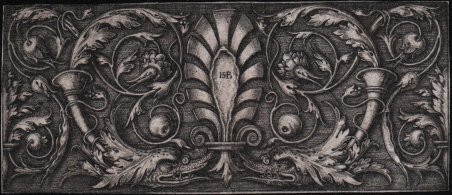Fregio ornamentale con al centro una palmetta. Intorno alla base della palmetta è posto un anello che racchiude le estensioni a volta di due teste di delfino. I viticci delle foglie, che crescono dalle teste dei delfini, scendono da ciascun lato al centro in basso, formando una testa, grottesca, di pesce. Bulino, circa 1540, firmata all’interno della palmetta con il monogramma ISB. Esemplare nel secondo stato descritto da Pauli, con la punta superiore della foglia della palmetta e la punta inferiore sul lato destro hanno un breve tratteggio incrociato. Nella parte centrale della palmetta a sinistra c'è una nuova posizione della linea. Poco prima del 1520, alcuni giovani artisti della cerchia di Albercht Dürer presero a realizzare incisioni molto piccole che hanno sfidato lo spettatore con un mondo in miniatura, un mondo di nuovo soggetto laico e di interpretazioni non convenzionali di temi tradizionali. A causa delle ridotte dimensioni delle loro incisioni, questi artisti sono stati appellati a lungo, con il nome collettivo, e poco lusinghiero, di Piccoli Maestri di Norimberga. Il nucleo del gruppo consiste in tre artisti di Norimberga, Hans Sebald & Bartel Beham e Georg Pencz, e inoltre Jacob Bink da Colonia e Heinrich Aldegrever da Soest. Magnifica prova, ricca di toni, impressa su carta vergata coeva, rifilata alla linea marginale, piccolo restauro all’angolo superiore sinistro, per il resto in ottimo stato di conservazione. Bibliografia Pauli 1901-11, Hans Sebald Beham: Ein Kritisches Verzeichniss seiner Kupferstiche Radirungen und Holzschnitte (240.II); Hollstein, German engravings, etchings and woodcuts c.1400-1700 (240.II); Bartsch, Le Peintre graveur (VIII.217.235); Irene M. de Groot, Ornamentprenten in het Rijksprentenkabinet, p. 156, cat.nr. 296; Peter Fuhring, 'Ornament Prints in Amsterdam', Print Quarterly 6 (1989), p. 329. Ornamental frieze with a palmette in the center. Surrounding the base of the palmette is a ring enclosing the vaulted extensions of two dolphin heads. Leaf tendrils, growing from the dolphin heads, descend from each side to the bottom center, forming a head, grotesque, of fish. Engraving, ca. 1540, signed inside the palmette with the monogram ISB. Example in the second state described by Pauli, with the upper tip of the palmette leaf and the lower tip on the right side have a short cross-hatch. There is a new line position in the middle part of the palmette on the left. Shortly before 1520, some young artists in Albercht Dürer's circle took to making very small engravings that challenged the viewer with a miniature world of new secular subject matter and unconventional interpretations of traditional themes. Because of the small size of their engravings, these artists have long been affixed with the collective, and unflattering, name of Small Nuremberg Masters. The core of the group consists of three artists from Nuremberg, Hans Sebald & Bartel Beham and Georg Pencz, and in addition Jacob Bink from Cologne and Heinrich Aldegrever from Soest. Magnificent proof, rich in tone, printed on contemporary laid paper, trimmed at marginal line, small restoration to upper left corner, otherwise in excellent condition. Bibliografia Pauli 1901-11, Hans Sebald Beham: Ein Kritisches Verzeichniss seiner Kupferstiche Radirungen und Holzschnitte (240.II); Hollstein, German engravings, etchings and woodcuts c.1400-1700 (240.II); Bartsch, Le Peintre graveur (VIII.217.235); Irene M. de Groot, Ornamentprenten in het Rijksprentenkabinet, p. 156, cat.nr. 296; Peter Fuhring, 'Ornament Prints in Amsterdam', Print Quarterly 6 (1989), p. 329. Cfr.

Scopri come utilizzare
Scopri come utilizzare

